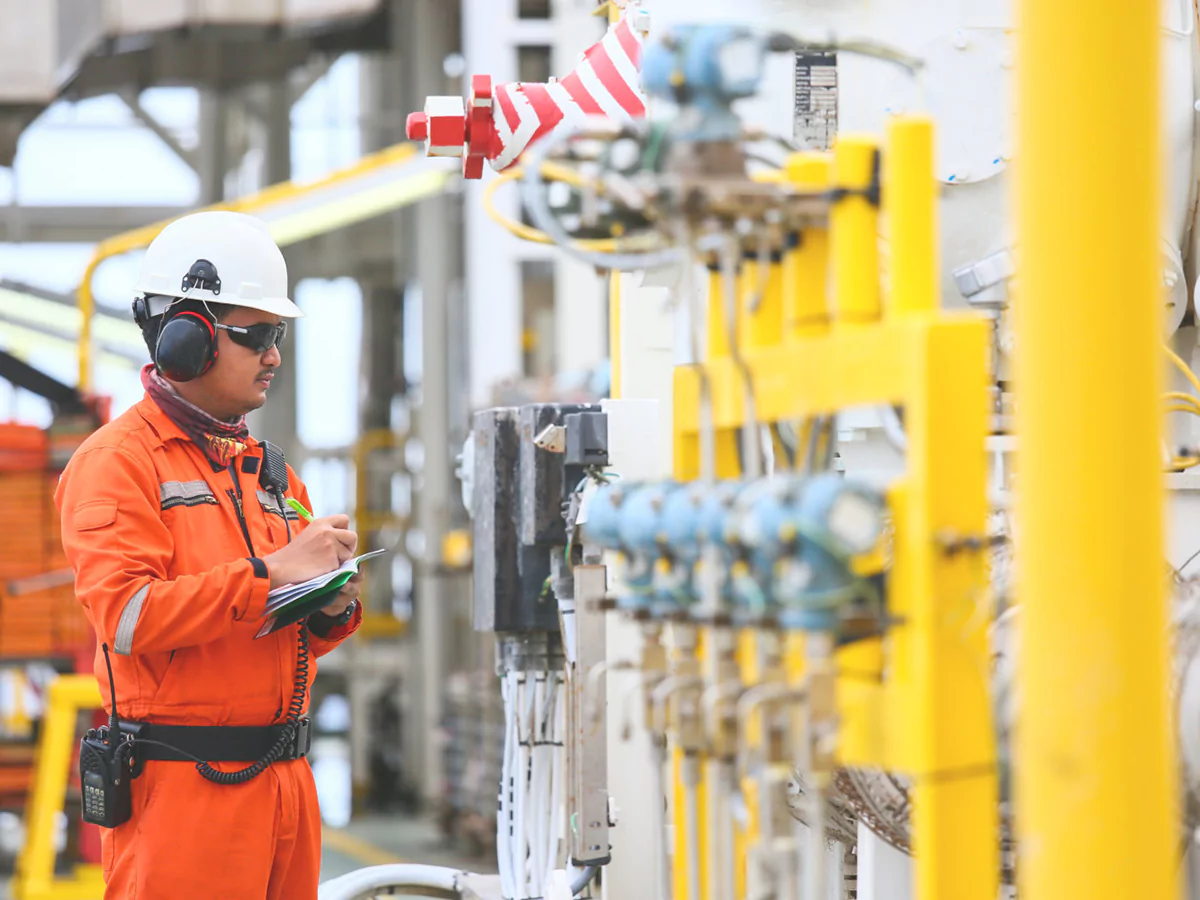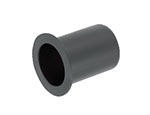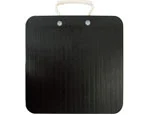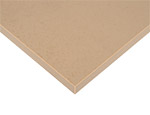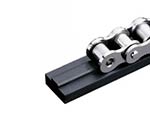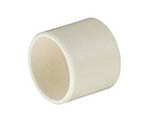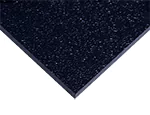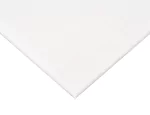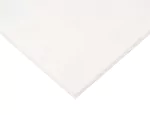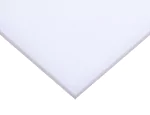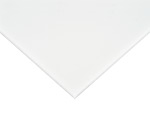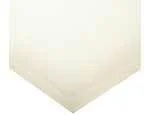Thermoplastics are a core material for creating bearings and bushings that are longer-lasting and more durable than their metal counterparts. Materials like nylon, acetal, PTFE, PEEK, and UHMW-PE are chosen for their durability, wear resistance, and low friction properties.
- Acetal is a thermoplastic with excellent dimensional stability, low coefficient of friction, and suitably high wear resistance. Its strength and rigidity allow acetal to bear high loads without deforming, particularly in precision applications. Acetal is also moisture-, chemical-, and fatigue-resistant. FDA-compliant grades of acetal can be used for applications where food contact may be a concern.
- Nylon is another thermoplastic with high mechanical strength, good wear resistance, and resistance to both chemicals and oils. Its wear and low friction properties reduce or eliminate the need for external lubrication, allowing it to operate in areas where lubrication may be impossible. Nylon is used for bearings in applications that see moderate loads and speeds, while in bushings, nylon is used when moderate wear resistance is required.
- PEEK is a high-performance material with exceptional mechanical properties that reliably performs even at high temperatures, loads, and stresses. It retains its physical properties at higher elevated temperatures than most thermoplastics and is suitable for use in environments where high performance is required, such as automotive bearings and bushings. PEEK also features superior chemical resistance and can function in corrosive or hostile environments.
- PTFE's lower coefficient of friction and self-lubricating properties minimize wear and extend the lifespan of bearings and bushings. Great chemical resistance and resistance to high temperatures allow it to operate under conditions where other materials may fail. Like nylon, PTFE's self-lubrication reduces or removes the need for external lubrication.
- UHMW-PE's low coefficient of friction and high abrasion resistance make it an ideal material for bearings. A moisture- and chemical-resistant material, UHMW can handle extended exposure to the high temperatures seen in steam or hot water cleaning without degradation of its physical properties. This allows for easy cleaning and sterilization that some industries require on a regular basis. UHMW is also self-lubricating, removing the need for lubricants and reducing the need for maintenance.
Rollers and slide pads for manufacturing equipment are made from plastics that have the necessary properties to handle repeated wear, heavy loads, and impacts without deforming. These plastics include nylon, PTFE, UHMW-PE, and acetal.
- Acetal's excellent dimensional stability, low friction, and wear properties make it a good fit for rollers and roller chains. Lower friction and higher wear resistance reduce the amount of drag and wear on the roller's surface, allowing for smoother operation and less maintenance overall. Acetal rollers are seen in manufacturing equipment for printing, packaging, and chemicals. FDA grades of acetal also see use in food processing equipment. Though nylon and UHMW are more commonly used as slide pads, acetal can be used for applications set in water or chemicals.
- Nylon's abrasion resistance, impact resistance, and wear properties underscore its suitability for both rollers and slide pads. Like acetal, nylon's wear properties promote smoother operation and lower maintenance costs. Nylon is self-lubricating - combined with its chemical resistance, nylon rollers and slide pads can endure environments where lubrication is impossible and where materials like metal may corrode and fail.
- PTFE is another chemically resistant plastic with a very low coefficient of friction that promotes smooth movement of rollers made from it. Its chemical resistance enables PTFE rollers to withstand corrosive substances, ensuring longer part lifespans and reliability in difficult or hostile conditions. PTFE operates over a wide temperature range without any loss in physical properties. PTFE is not suited for use as slide pads.
- UHMW-PE is one of the primary plastics used for slide pads. Compared to metal, UHMW slide pads are lighter, immune to corrosion and rust, are waterproof, easy to maintain, and are relatively cost-effective. A low coefficient of friction combined with high impact strength also makes it suited to work as rollers for conveyor systems or material handling equipment.
The MRO sector depends upon plastics for electrical insulators that prevent unwanted shocks and accidents from occurring in many applications. Plastics like PVC, PE, PTFE, PC, and phenolic composites exhibit excellent dielectric properties that are critical to preventing electrical currents from flowing through them.
- Phenolics are thermoset composite materials that see widespread use as electrical insulators in MRO equipment. Made from a combination of fabric or paper and a binding resin or laminate, phenolics generally have excellent insulating properties, high mechanical strength, and thermal stability. Of the phenolic grades, phenolic paper and phenolic canvas electrical grade (CE) are standouts for electrical insulation.
- Polycarbonate has a combination of electrical insulating properties, thermal stability, and high impact resistance that makes it great for protective covers in industrial and electrical applications. Polycarbonate is virtually unbreakable and operates over a wide temperature range.
- Polyethylene, or PE, is widely used in wire insulation, cable jacketing, and electrical enclosures due to its excellent dielectric properties and moisture resistance. As a moisture-resistant material, PE can function in wet environments without conducting electricity.
- PTFE features outstanding dielectric properties and is a thermally stable material, allowing for its use in insulating electrical components. PTFE's dielectric properties are stable over a wide temperature range, allowing it to effectively prevent current leakage and allow safe operation in many industrial and manufacturing environments. PTFE is also highly resistant to chemicals and corrosion and can operate in harsh environments where it may be exposed to corrosive substances.
- Polyvinyl Chloride or PVC, is another thermoplastic widely used as an electrical insulator. It exhibits good dielectric properties and is resistant to flame, making it an effective insulator that won't immediately melt when exposed to fire. PVC has good resistance to chemicals, moisture, and UV rays, allowing for its use in both indoor and outdoor settings.
Seals and gaskets require materials that resist wear and tear, are chemically compatible with any fluids that may touch the seal or gasket, and can handle temperature variations. Plastics like nylon, PEEK, phenolic, polypropylene, PTFE and polyurethane have the necessary properties to serve as seals and gaskets in many applications.
- Nylon is used in seal and gasket applications for its toughness and wear properties, particularly where dynamic sealing is required. Its resistance to abrasion, chemicals, and dimensional stability allow it to serve as an effective seal in many applications.
- PEEK is a high-performance thermoplastic with outstanding mechanical and thermal properties. Its strength allows it to handle mechanical stress and high pressure without deforming and it is resistant to many chemicals, allowing for its use as long-lasting and reliable gaskets or seals in a number of environments.
- Phenolics provide excellent thermal and mechanical properties for seals and gaskets - they are strong, chemically resistant, and have great thermal stablility. They are also relatively easy to machine and come in different grades with variable properties that allow phenolics to cover many different seal or gasket applications.
- Polypropylene is chosen for use in seals and gaskets because of its flexibility, low moisture absorption, and resistance to chemicals. Its flexibility allows it to form a tight seal to prevent leaks and maintain integrity over time. Polypropylene's low moisture absorption makes it suited for environments where prolonged exposure to moisture is a concern.
- Polyurethane is another excellent material for seals and gaskets - it is a flexible, abrasion resistant, and durable material that can withstand a wide range of temperatures. Polyurethane's durable yet flexible nature allows it to withstand high pressures without deforming or cracking - the seal will return to its original shape. Like PTFE, polyurethane is also resistant to wear and tear, allowing for less frequent maintenance and replacement.
- PTFE is a go-to thermoplastic for seals and gaskets thanks to its exceptional chemical resistance, low friction properties, and ability to handle a wide range of temperatures. Its chemical resistance keeps its physical properties intact even with prolonged exposure to chemicals, making it a good choice for seals or gaskets in chemical or food processing. PTFE's low coefficient of friction means less wear and tear on the seal or gasket, extending part lifespans. Its effective temperature range ensures it can handle temperature variations in industrial environments where significant or frequent temperature changes are a concern.
Corner tracks, rails, bumpers, and other essential small components for manufacturing operations are made from smooth and impact-resistant materials that can be molded into the correct shape and will retain it after repeated impacts. The MRO sector turns to plastics like UHMW, nylon, and acetal for the creation of these small but important components.
- Acetal's properties make it a good choice for small components like shaft collars, roller chains, and gears. Acetal brings its strength, resistance to chemicals, dimensional stability, and low friction properties to each application. Acetal may be machined to close tolerances for precision parts. Its moisture resistance and chemical resistance make it suitable for small components in environments with harsh chemicals or moisture.
- Nylon is chosen for gears, gear racks, collars, sprockets, and other small components in MRO equipment. Its combination of wear properties, chemical resistance, dimensional stability, and mechanical strength places it as a reliable and long-lasting material that extends part life compared to metal components. Its wear properties enable smoother, quieter operation of equipment and its abrasion resistance makes nylon a suitable material for power transmission applications.
- UHMW-PE is a versatile low-friction material and one of the primary plastics used for corner tracks, guide rails, wear strips, bumpers, and more due to its durability, light weight, and resistance to abrasion and chemicals. UHMW is self-lubricating, reducing the amount of friction generated and extending part life. Specialized grades of UHMW are available for use in enhancing material flow through conveyors, chutes, hoppers, and more.
Plastics such as acetal, polypropylene, PTFE, and PEEK offer a unique combination of properties that provide distinct advantages over other materials for valve components in MRO applications. They are chemically resistant and will not corrode, have low friction properties, and are are lightweight. These characteristics make them popular choices for valve components that will last longer and operate more efficiently.
- Acetal's mechanical strength and stability allow valve components to be machined to close/precise tolerances, which is critical for valves to operate properly. Low friction and good wear resistance ensure part longevity over similar non-plastic materials. Acetal's low moisture absorption and chemical resistance allows for its use in fluid handling systems and applications where other materials may become compromised over time.
- Polypropylene is another popular material for valve components. It features excellent chemical resistance, light weight, and is cost-effective compared to similar materials. Polypropylene has good mechanical strength and is used for valve components in valves that control or regulate the flow of fluids in chemical processing, water treatment, or other industrial applications. Polypropylene is best suited for less demanding environments.
- PTFE is used for valve components in chemical processing, pharmaecuticals, and the oil and gas industries due to its outstanding chemical and corrosion resistance. Its low coefficient of friction enables smoother operation of valve components compared to other materials and extends their lifespan. PTFE operates over a wide range of temperatures and can handle extreme thermal environments.
- PEEK is a high-performance material used for valve components in industries like aerospace, oil and gas, and chemical processing that require exceptional mechanical properties, chemical resistance, and thermal stability. PEEK handles high pressures and stresses without losing shape and can withstand many chemicals - this material won't corrode. Its thermal properties make it suitable for valves in high and low temperature environments.
Windows provide visibility and protection for many manufacturing applications, allowing personnel to monitor processes and the state of equipment without exposing themselves to potentially hazardous chemicals, temperatures, or machinery in motion. Plastics like polycarbonate and acrylic provide the clarity and transparency to observe as well as the necessary protection needed to keep personnel safe.
- Polycarbonate is a virtually unbreakable lightweight thermoplastic with excellent optical clarity and transparency. These properties make it a preferred material for windows where durability and protection are necessary. Its impact resistance and durability allows it to withstand impacts from debris, tools, and other potential missiles. Aside from windows, polycarbonate can also be used as protective barriers, machine guards, and in enclosures.
- Acrylic is a similarly clear material that is stronger than glass, but less durable than polycarbonate. It is lighter than glass and is a good fit for windows where weight and visibility may be important. Though less impact-resistant than polycarbonate, acrylic is more resistant to UV damage, allowing for its use outside without yellowing or degrading.
Housings are specifically created and formed or molded to protect sensitive internal components and must be able to handle impacts, shocks, vibrations, chemical spills, and other hazards effectively. Plastics like ABS, nylon, polycarbonate, polypropylene, and PVC are easily machined or thermoformed into the necessary shapes for housing and possess the inherent characteristics to protect those sensitive components.
- ABS is a moldable and thermoformable plastic with a good combination of impact, chemical, and electrical resistance. ABS housing protects its internal components from shocks and impacts, and its chemical resistance allows for continued protection even in environments where industrial chemicals may spill. ABS is cost-effective, lightweight, and easily molded or formed into complex shapes for custom housings that fit space requirements.
- Nylon's mechanical strength is harnessed in protective housings that are chemically resistant and able to maintain their structural integrity under varying temperatures.
- Polycarbonate has a combination of electrical insulating properties, thermal stability, and high impact resistance that allows housings made from it to protect the components inside from impacts, vibrations, and electrical shocks. Polycarbonate is a virtually unbreakable plastic and can be thermoformed into complex shapes.
- Polypropylene, or PP, is also used for the creation of housings. Durable, lightweight, and chemically resistant, polypropylene is well-suited to environments where chemical exposure is common and can protect internal components from them without degrading. Polypropylene housings see use in fluid handling and chemical containers.
- Polyvinyl Chloride, or PVC, has good chemical resistance, durability, and flame retardant properties. Like polypropylene, PVC is suited to protect components in environments where corrosive substances are common. PVC resists moisture and UV radiation, allowing for its use both indoors and outdoors.










